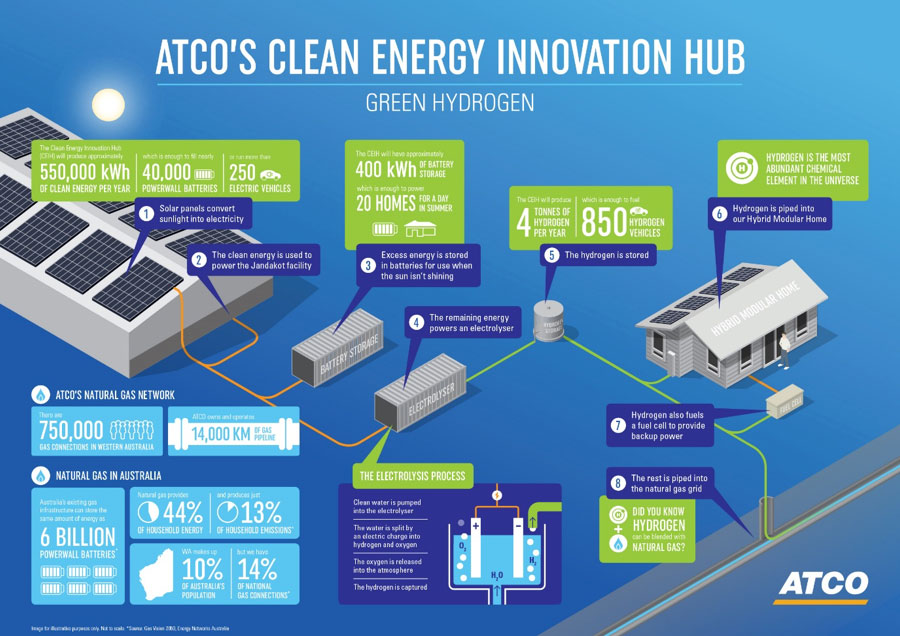Canada’s gas major ATCO will trial the production, storage and use of renewable hydrogen to energize a commercial-scale micro grid in Jandakot, Western Australia, and assess the practicalities of replacing natural gas with hydrogen at a city-wide scale across a municipality.
On behalf of the Australian Government, the Australian Renewable Energy Agency (ARENA) has announced $1.5 million to fund the $3.3 “green hydrogen“ innovation hub, touted as Australia’s first.
The micro grid will comprise approximately 1100 solar panels, capable of generating 300kW of power – around two and half times the daily power requirements of the facility, and 400kWh of batteries.
In a nutshell, the Clean Energy Innovation Hub (CEIH) will work as follows: solar energy is used to power the Jandakot facility, while excess energy is stored in batteries. The remaining energy is used to power an electrolyzer that separates water molecules into oxygen and hydrogen. The hydrogen is then stored as fuel for a back-up generator or blended with natural gas.
In addition to testing the use of hydrogen in different settings and applications including in household appliances, the project will provide insights into optimizing hydrogen storage and distribution solutions, blending hydrogen with natural gas and using hydrogen as a balancing fuel to support the grid.
ARENA CEO Ivor Frischknecht said the ATCO trial could lead to hydrogen being used more widely across Australia. “Green hydrogen offers opportunities to provide carbon free energy to cities and towns, while leveraging existing natural gas infrastructure,” he said.
Overall, the CEIH is the latest among a number of projects across Australia looking to use “green hydrogen”, such as South Australia’s 50 MW hydrogen electrolyzer developed by Neoen alongside a 150 MW wind project and a 150 MW solar farm, or a project near Port Lincoln by Australia’s Hydrogen Utility involving a 30MW water electrolysis plant, which is to provide balancing services to the grid and fast frequency response support to new solar plants under development.
For ATCO, the Jandakot project is an extension of its existing GasSola Residential Hybrid Energy System trial for nine sites in Western Australia’s south west, which integrates solar PV and battery storage with localized household natural gas electricity generation.
“Securing this grant is a major accomplishment,“ said ATCO Managing Director and Chief Operating Officer Pat Creaghan.
“The project has many exciting elements, but what truly sets it apart is the use of excess renewable energy, which would typically be lost to the system, to produce hydrogen,” he added.
The Clean Energy Innovation Hub is expected to be fully operational in 2019 with first results from the micro grid expected to be available later that year.
This content is protected by copyright and may not be reused. If you want to cooperate with us and would like to reuse some of our content, please contact: editors@pv-magazine.com.









By submitting this form you agree to pv magazine using your data for the purposes of publishing your comment.
Your personal data will only be disclosed or otherwise transmitted to third parties for the purposes of spam filtering or if this is necessary for technical maintenance of the website. Any other transfer to third parties will not take place unless this is justified on the basis of applicable data protection regulations or if pv magazine is legally obliged to do so.
You may revoke this consent at any time with effect for the future, in which case your personal data will be deleted immediately. Otherwise, your data will be deleted if pv magazine has processed your request or the purpose of data storage is fulfilled.
Further information on data privacy can be found in our Data Protection Policy.